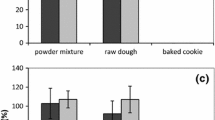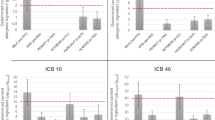Abstract
For detection and quantification of food proteins triggering hypersensitivity reactions, reliable, validated analytical methods are necessary. At present, the most commonly used methodology for this purpose is ELISA. The lack of incurred reference materials (RM) complicates the fulfilling of method validation. Today, a well identifiable research direction is the development of methods (immunoanalytical, PCR and MS methods) suitable for multi-component analysis. As a consequence of these R+D efforts, the development of multi-component RMs is reasonable. Our work presented here is focusing on the development and investigation of multi-component model food matrices that can be suitable for supporting the validation processes. On the basis of the relative incidence of hypersensitivity reactions, four components—wheat, milk, egg and soy—were selected for our preliminary work. The target proteins were determined in single- and multi-component matrices with different ELISA methods, and the results were compared by statistical evaluation. The main direction of our investigation was to identify the effects of the potential interactions of these proteins on the analytical results, and the influence of food processing was also investigated. The results showed that the presence of multiple allergenic components caused much less uncertainty in the analytical results than analytical and technological steps, such as sample preparation, repetition or even heat treatment. However, probably due to the relatively complex matrices, some discrepancies from the expected outcome could also be observed.





Similar content being viewed by others
References
Sicherer SH, Sampson H (2010) Food allergy. J Allergy Clin Immun 125(2):116–125
Taylor SL, Hefle SL (2001) Food allergies and other food sensitivities. Food Technol 55(9):68–83
Taylor SL, Gendel SM, Houben GF, Julien E (2009) The key events dose-response framework: a foundation for examining variability in elicitation thresholds for food allergens. Crit Rev Food Sci Nutr 49:729–739
Codex Alimentarius (1985) General standard for the labelling of prepackaged foods. Codex Stan 1-1985
Gendel SM (2012) Comparison of international food allergen labeling regulations. Regul Toxicol Pharm 63(2):279–285
EU Regulation No 1169/2011 of the European Parliament and of the Council. Off J EU 304:18-63
Directive 2003/89/EC of the European Parliament and of the Council. Off J EU 308:15-18
Koppelman SJ, Hefle SL (2006) Detecting allergens in food. Woodhead Publishing Ltd, Cambridge
Berger R, Schmidt G (1996) Evaluation of six anti-gliadin antibody assays. J Immunol Methods 191:77–86
Bugyi Z, Török K, Hajas L, Adonyi Z, Popping B, Tömösközi S (2013) Comparative study of commercially available gluten ELISA kits using an incurred reference material. Qual Assur Saf Crop 5(1):79–87
van Eckert R, Bond J, Rawson P, Klein CL, Stern M, Jordan TW (2010) Reactivity of gluten detecting monoclonal antibodies to a gliadin reference material. J Cereal Sci 51(2):198–204
Garber EAE, Perry J (2010) Detection of hazelnuts and almonds using commercial ELISA test kits. Anal Bioanal Chem 396(5):1935–1945
Scharf A, Kasel U, Wichmann G, Besler M (2013) Performance of ELISA and PCR methods for the determination of allergens in food: an evaluation of six years proficiency testing for soy (Glycine max L.) and wheat gluten (Triticum aestivum L.). J Agric Food Chem 61(43):10261–10272
Monaci L, Tregoat V, van Hengel AJ, Anklam E (2006) Milk allergens, their characteristics and their detection in food: a review. Eur Food Res Technol 223:149–179
Gessendorfer B, Wieser H, Koehler P (2010) Optimisation of a solvent for the complete extraction of prolamins from heated foods. J Cereal Sci 52(2):331–332
Heick J, Fischer M, Popping B (2012) Influence of sample extraction solutions on the detection of wheat proteins by mass spectrometry. J AOAC Int 95(2):388–394
Hildebrandt S, Steinhart H, Paschke A (2008) Comparison of different extraction solutions for the analysis of allergens in hen’s egg. Food Chem 108(3):1088–1093
Kleber N, Krause I, Illgner S, Hinrichs J (2004) The antigenic response of β-lactoglobulin is modulated by thermally induced aggregation. Eur Food Res Technol 219:105–110
Hayta M, Schofield JD (2004) Heat and additive induced biochemical transitions in gluten from good and poor breadmaking quality wheats. J Cereal Sci 40(3):245–256
Mills EN, Sancho AI, Rigby N, Jenkins J, Mackie AR (2009) Impact of food processing on the structural and allergenic properties of food allergens. Mol Nutr Food Res 53(8):963–969
Tatham AS, Shewry PR (2008) Allergens to wheat and related cereals. Clin Exp Allergy 38(11):1712–1726
Cabanillas B, Maleki SJ, Rodríguez J, Burbano C, Muzquiz M, Jiménez MA, Pedrosa MM, Cuadrado C, Crespo JF (2012) Heat and pressure treatments effects on peanut allergenicity. Food Chem 132(1):360–366
Monaci L, Brohée M, Tregoat V, van Hengel A (2011) Influence of baking time and matrix effects on the detection of milk allergens in cookie model food system by ELISA. Food Chem 127(2):669–675
Singh H, MacRitchie F (2004) Changes in proteins induced by heating gluten dispersions at high temperature. J Cereal Sci 39(2):297–301
Tong P, Gao J, Chen H, Li X, Zhang Y, Jian S, Wichers H, Wu Z, Yang A, Liu F (2012) Effect of heat treatment on the potential allergenicity and conformational structure of egg allergen ovotransferrin. Food Chem 131(2):603–610
ISO Guide 30 (1992) Terms and definitions used in connection with reference materials. ISO, Geneva
Bugyi Z, Török K, Hajas L, Adonyi Z, Poms RE, Popping B, Diaz-Amigo C, Kerbach S, Tömösközi S (2012) Development of incurred reference material for improving conditions of gluten quantification. J AOAC Int 95(2):382–387
Bugyi Z, Nagy J, Török K, Hajas L, Tömösközi S (2010) Towards development of incurred materials for quality assurance purposes in the analysis of food allergens. Anal Chim Acta 672(1–2):25–29
Diaz-Amigo C, Popping B (2013) Accuracy of ELISA detection methods for gluten and reference materials: a realistic assessment. J Agr Food Chem 61(24):5681–5688
Dumont V, Kerbach S, Poms R, Johnson P, Mills C, Popping B, Tömösközi S, Delahaut P (2010) Development of milk and egg incurred reference materials for the validation of food allergen detection methods. Qual Assur Saf Crop 2(4):208–215
van Eckert R, Berghofer E, Ciclitira PJ, Chirdo F, Denery-Papini S, Ellis HJ, Ferranti P, Goodwin P, Immer U, Mamone G, Mendez E, Mothes T, Novalin S, Osman A, Rumbo M, Stern M, Thorell L, Whim A, Wieser H (2006) Towards a new gliadin reference material–isolation and characterisation. J Cereal Sci 43(3):331–341
Lacorn M, Immer U (2011) Allergen determination in food: reference materials and traceability of results. Accredit Qual Assur 16(8–9):449–452
Blais BW, Gaudreault M, Phillippe LM (2003) Multiplex enzyme immunoassay system for the simultaneous detection of multiple allergens in foods. Food Cont 14(1):43–47
Heick J, Fischer M, Popping B (2011) First screening method for the simultaneous detection of seven allergens by liquid chromatography mass spectrometry. J Chromatogr A 1218(7):938–943
Köppel R, van Velsen-Zimmerli F, Bucher T (2012) Two quantitative hexaplex real-time PCR systems for the detection and quantification of DNA from twelve allergens in food. Eur Food Res Technol 235(5):843–852
Gomaa A, Boye JI (2013) Impact of thermal processing time and cookie size on the detection of casein, egg, gluten and soy allergens in food. Food Res Int 52(2):483–489
Gomaa A, Ribereau S, Boye JI (2012) Detection of allergens in a multiple allergen matrix and study of the impact of thermal processing. J Nutr Food Sci 9:1–6
Li Z, Luo Y, Feng L (2011) Effects of Maillard reaction conditions on the antigenicity of α-lactalbumin and β-lactoglobulin in whey protein conjugated with maltose. Eur Food Res Technol 233:387–394
Downs ML, Taylor SL (2010) Effects of thermal processing on the enzyme-linked immunosorbent assay (ELISA) detection of milk residues in a model food matrix. J Agric Food Chem 58(18):10085–10091
Wieser H, Koehler P (2009) Is the calculation of the gluten content by multiplying the prolamin content by a factor of 2 valid? Eur Food Res Technol 229:9–13
Acknowledgments
This research is related to the scientific goals of MoniQA Association and the Hungarian national project “Development of quality orientated, harmonised educational and R+D+I strategy and operational model at the Budapest University of Technology and Economics” (ÚMFT TÁMOP-4.2.1/B-09/1/KMR-2010-0002).
Conflict of interest
The authors declare that they have no conflict of interest.
Compliance with Ethics Requirements
This article does not contain any studies with human participants or animals performed by any of the authors. Informed consent was obtained from all individual participants included in the study.
Author information
Authors and Affiliations
Corresponding author
Rights and permissions
About this article
Cite this article
Török, K., Horváth, V., Horváth, Á. et al. Investigation of incurred single- and multi-component model food matrices for determination of food proteins triggering allergy and coeliac disease. Eur Food Res Technol 239, 923–932 (2014). https://doi.org/10.1007/s00217-014-2289-6
Received:
Revised:
Accepted:
Published:
Issue Date:
DOI: https://doi.org/10.1007/s00217-014-2289-6




